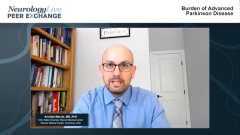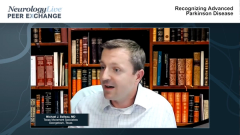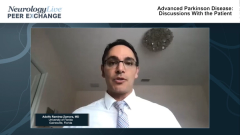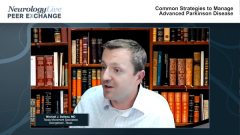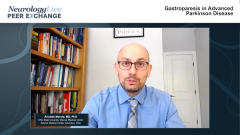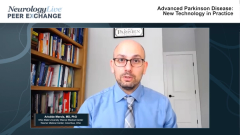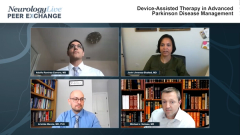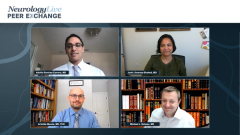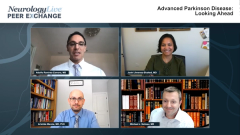
Advanced Parkinson Disease: Looking Ahead
Panelists look ahead in the management of advanced Parkinson disease and discuss the promise of different investigational therapies.
Episodes in this series

Adolfo Ramirez-Zamora, MD: We have discussed so many intricacies about [Parkinson disease], and we probably could keep talking about some of these issues for a while. But I cannot believe we have had a discussion for almost an hour and a half. The points [we’ve discussed] are really well taken. Like Joohi said, all the devices have different features, but the important factor is that you have a good neurologist and a good surgeon because having the lead in the right spot is going to help. Patient selection, like Ari mentioned, is critical as well for any of these therapies. And Michael, just like you said, you need a multidisciplinary approach to provide the best therapies for some of these patients.
Before we finish with our talk today, I would love to ask you all about what seems exciting on the horizon. What are the new therapies and things that excite you about the future in management and research in Parkinson disease [PD]? If you could incorporate a brief take-home message for all the community neurologists who are treating these patients with Parkinson disease, what would that be? Michael, can I start with you?
Michael J. Soileau, MD: Sure. I’ve already mentioned some things I’m excited about. But I would say that the thought of having therapies that can make these patients’ lives more convenient, more predictable, and with better quality of life, I think, is very exciting. And even better, if we can diagnose this condition earlier and find a way to keep it from progressing, that would be a huge leap forward in the treatment of these patients. There is so much work that’s been done even in the last year on that.
Then for my general neurology colleagues out there, I know that most are short on time, like we all feel when we’re with these patients. We talked about education and so many wonderful things, and I know there are those out there listening tonight who are saying, “Well, that’s great if you have an hour and a half to spend with these patients, but I have 15 minutes. So, in 15 minutes, what do I need to know for this patient?” I would say being present, seeing them often, and helping to address their nonmotor and motor complaints frequently is to their advantage. Then lean on your resources and leverage those around you, such as support groups. Hopefully, if it’s time for advanced therapy like we talked about today, please, early is better, in our opinion, to have them be consulted by your local movement disorder specialist.
A blessing of COVID-19 is that we have reduced the barrier to access of care through virtual clinics. Much of what we do is observation, especially in movement disorders. That excites me as well because now, in Austin, Texas, I’m able to see patients in El Paso very easily instead of them making an 8-hour trip 1 way to the clinic. It’s really helped access of care. Those are the things I’m very excited about that we’ve seen and what’s ahead.
Adolfo Ramirez-Zamora, MD: Perfect. Thank you so much, Michael. Ari, what seems exciting in the future for you? And 1 quick take-home message for our general neurology colleagues.
Aristide Merola, MD, PhD: I’m excited about advanced therapies. On one hand, advanced therapies like deep brain stimulation [DBS] have been around for 30 years, but the way we do it today is not the way it was done 30 years ago. We have the integration of advanced imaging into this approach. There are new tools for robotic surgery. This is very exciting to me. And of course, I’m excited about gene therapy. Gene therapy is up and coming, these new approaches to try to finally have a disease-modification approach. Is it working? We still don’t know, but clinical trials are ongoing, and there is a lot of hope for patients. My take-home message is [emphasizing the importance] of creating a network between institutions working on advanced therapies and the general neurologists, or people working more in the community. Especially now with telecommunication, it’s easier to talk with colleagues and discuss cases. This is something that can even further facilitate the referral of patients and continuous management.
Adolfo Ramirez-Zamora, MD: Perfect. Thank you so much. Joohi, would you give us your take-home message and what seems exciting in the near or long future in Parkinson disease?
Joohi Jimenez-Shahed, MD: I think the things that were already stated as exciting developments in the field of Parkinson disease, I certainly share the excitement there, especially about DBS. I think you’ve heard us talk a little about the ability to sense the brain signals, and I think what’s going to come next is the opportunity to be able to improve upon that therapy, as Ari spoke about, by delivering it in a very fundamentally different way, a fluctuating and on-demand type of way, doing it the way that that person needs it done as opposed to just being ON all the time. That’s the thing I find most exciting about the Parkinson world, not just in DBS, but that we are making advances on this concept of personalized therapy for Parkinson disease. Whether that’s based on a genetic mutation that an individual has, or maybe it’s based on an opportunity to clear alpha-synuclein from the brain and to see how that potentially works, and to understand which are the patients for which these therapies are going to work the best. That opportunity is, I think, an amazing place we are in these days.
My advice or take-home message is that caring for a patient with Parkinson disease is more than just adjusting their medications. Take the opportunity to understand the patients a little better, what they’re doing, what their needs are. Because we may miss opportunities to significantly help them if we’re not addressing the big picture. Each patient is going to bring different things to the table, so trying to understand what those different aspects of living with PD mean for that individual patient is an approach that I’m sure we all take with how we care for them.
Adolfo Ramirez-Zamora, MD: I think there are a lot of opportunities and new things coming in the field of Parkinson disease. I want to take a minute to thank all my colleagues for participating in today’s discussion. And thank you all for watching this NeurologyLive® Peer Exchange. If you enjoyed the content, please subscribe to our e-newsletter to receive upcoming Peer Exchanges and other great content right in your inbox. Thank you so much.
Transcript Edited for Clarity
Newsletter
Keep your finger on the pulse of neurology—subscribe to NeurologyLive for expert interviews, new data, and breakthrough treatment updates.

